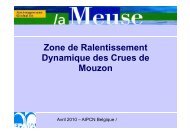PIANC E-Magazine - PIANC AIPCN welcome
PIANC E-Magazine - PIANC AIPCN welcome
PIANC E-Magazine - PIANC AIPCN welcome
You also want an ePaper? Increase the reach of your titles
YUMPU automatically turns print PDFs into web optimized ePapers that Google loves.
crown walls, Froude similarity and physical model<br />
tests are used to obtain the empirically-related<br />
factors involved in the process and an empirical<br />
calculation method to estimate the forces.<br />
The prediction models proposed over the years<br />
include:<br />
1) Iribarren (1954) proposed triangular distributions<br />
(see Figure 3a) for the dynamic and hydrostatic<br />
pressures, based on the maximum<br />
horizontal crest speed after the wave breaks<br />
on the slope.<br />
2) Jensen (1984) studied the influence of the<br />
wave height, period and sea level. Jensen<br />
(1984) concluded that the influence of sea level<br />
variations can be expressed as the berm freeboard<br />
and that the horizontal force is directly<br />
proportional to Hs/As. The wave period shows<br />
a clear trend: when the period increases, the<br />
forces increase too.<br />
Jensen‘s formulae should only be used when<br />
the input parameters are very similar to those<br />
reported in Jensen (1984), limiting their application<br />
to situations of moderate overtopping.<br />
Jensen (1984) did not propose a distribution<br />
of pressures, so it is not possible to get the<br />
unstabilising moments, although overturning is<br />
not a critical failure mode.<br />
3) Günback and Göcke (1984) proposed a method<br />
to calculate the pressures based on run-up.<br />
They separated the action of the waves on the<br />
vertical wall into two simultaneous distributions:<br />
a hydrostatic one extended up to the end<br />
of the wedge run-up representing the mass of<br />
water that hits the wall and a rectangular one<br />
associated with the kinetic energy of the wave<br />
(see Figure 3b). They proposed a triangular<br />
distribution for the up-lift forces.<br />
4) Bradbury (1988) investigated the influence of<br />
the slope on the loads over the superstructure,<br />
but did not draw clear conclusions about its<br />
influence. The results support those reported<br />
by Jensen (1984), i.e. proportionality between<br />
force and wave height and an increase in the<br />
forces with the wave period.<br />
5) Hamilton and Hall (1992) conducted a parametric<br />
research through laboratory tests to determine<br />
crown wall stability when subjected to<br />
regular waves. Their main findings are:<br />
• The increase in forces is directly proportional<br />
to wave height at moderate overtopping<br />
rates: from this point, the increase in forces<br />
decreases until approaching an horizontal<br />
asymptote.<br />
• Forces increase with the period, but the authors<br />
do not provide clear conclusions.<br />
• The smoother the slope, the lower the forces.<br />
• Crown wall stability greatly decreases when<br />
placed just on the riprap (provided that the<br />
crown walls used in the tests conducted by<br />
Hamilton and Hall (1992) have a smooth<br />
base).<br />
• The use of heels in the crown walls increases<br />
resistance to sliding compared to crown<br />
walls without heels; length is not relevant.<br />
6) Pedersen and Burchart (1992) studied the influence<br />
of certain parameters on the stability of<br />
the crown wall. Their conclusions are similar to<br />
those of Hamilton and Hall (1992) and Jensen<br />
(1984):<br />
• The higher the wave height, the higher the<br />
load on the crown wall.<br />
• The longer the period, the stronger the actions<br />
on the crown wall.<br />
• The Hs/As parameter displays a clear linear<br />
dependence with the force.<br />
• Non-conclusive results are obtained regarding<br />
the influence of the berm width.<br />
• Forces on crown walls depend on the area<br />
non-protected by the berm. When the height<br />
of the vertical wall is very high, a maximum<br />
value that depends only on the sea conditions<br />
and the sea level is reached.<br />
7) Burchart (1993) presented a formula for force<br />
calculation based on the idea of Günback and<br />
Göcke (1984) extending the wedge run-up until<br />
the imaginary prolongation of the slope is<br />
reached. For simplicity, Burchart (1993) did<br />
not separate the force into an impulsive one<br />
and a hydrostatic one, but considered it as<br />
a fictitious hydrostatic force. Burchart (1993)<br />
31<br />
<strong>PIANC</strong> E-<strong>Magazine</strong> n° 144, November/novembre 2011




